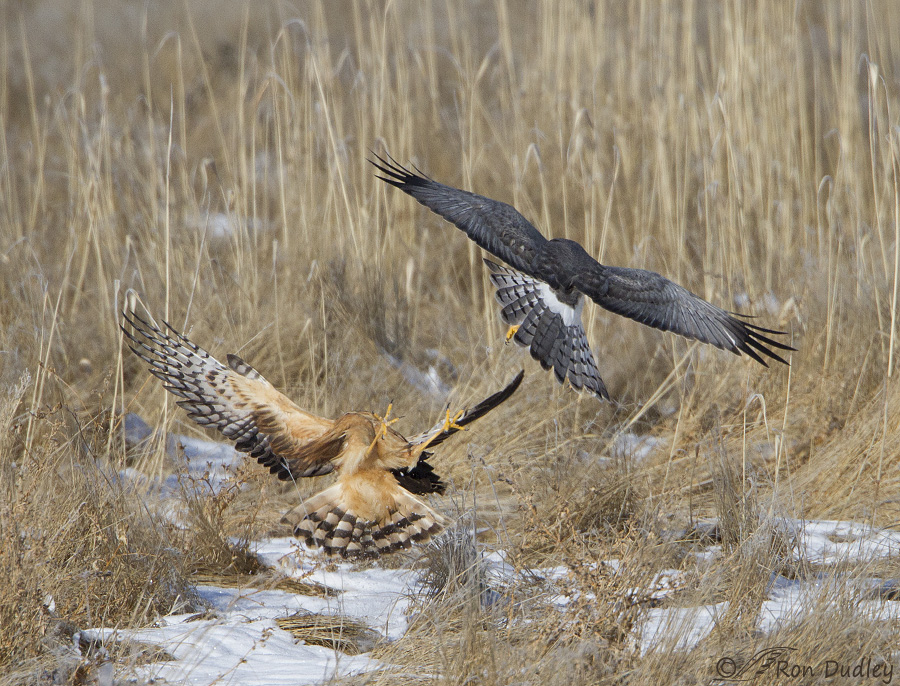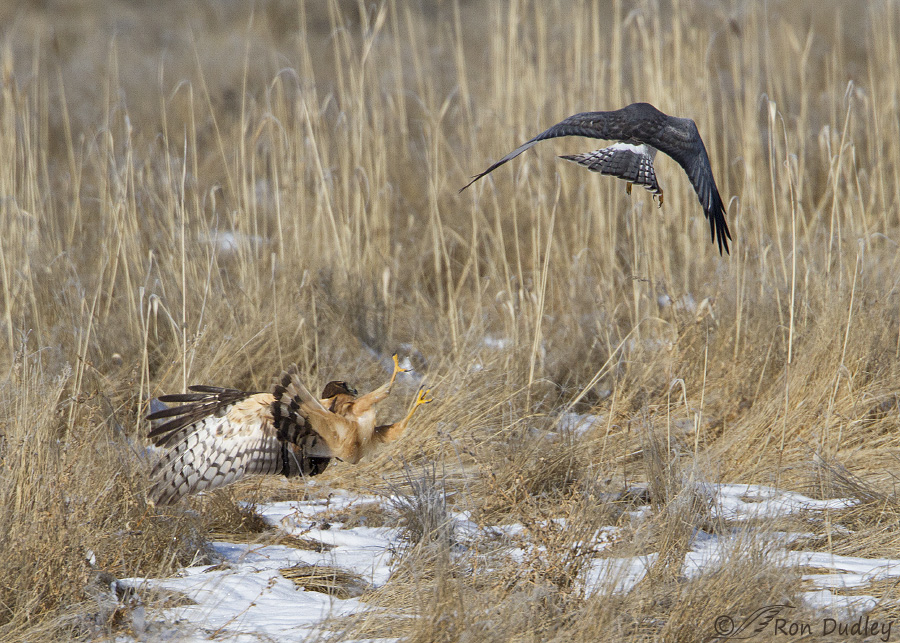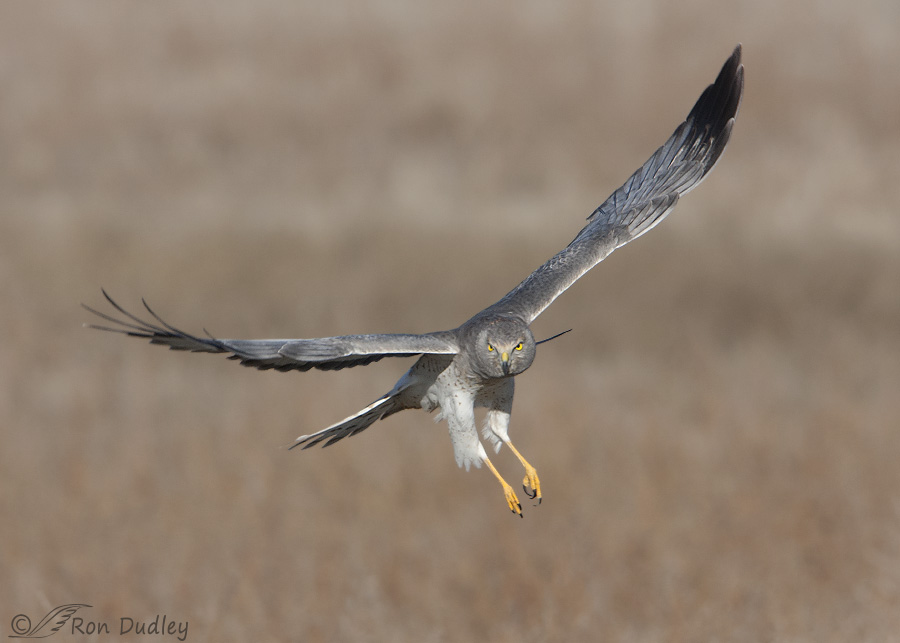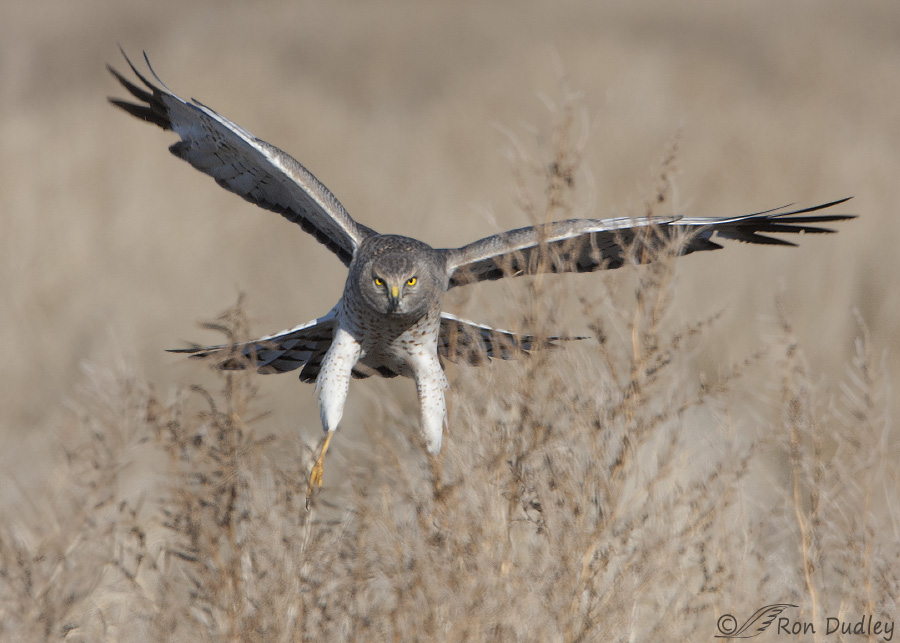And readers know I’m not a fan of most photo contests.
Occasionally I go way back into my archives to see what birds I’ve photographed this time of year in the past as an indicator of where I might mind them now. So last night I fired up an old hard drive and stumbled across a few Northern Harrier shots taken at Farmington WMA years ago that I thought readers might enjoy seeing.

1/3200, f/8, ISO 400, Canon 7D, Canon EF 500mm f/4L IS USM + EF 1.4 Extender, not baited, set up or called in
Exactly eight years ago today, on 11/24/09 when I was still a relative novice at bird photography, I was barely able to document this dramatic encounter between a Northern Harrier perched on the ground and an adult male harrier (Gray Ghost) swooping in to attack it. The perched bird saw the male approaching and at the very last second it hopped up from the ground and turned completely upside down so it could present its talons defensively.
I’ve captured similar defensive postures from fighting male Short-eared Owls in the past but this is only time I’ve been able to do so with harriers. I barely got my lens on the birds before this shot was taken.

1/4000, f/8, ISO 400, Canon 7D, Canon EF 500mm f/4L IS USM + EF 1.4 Extender, not baited, set up or called in
In the next frame the previously perched bird is still trying to recover from the near-attack and land on its feet after the male veered away at the very last split-second. It was all over in a flash.

1/1000, f/9, ISO 500, Canon 40D, Canon EF 500mm f/4L IS USM + EF 1.4 Extender, not baited, set up or called in
And during that same journey through the ancient hard drive I found a couple of more interesting and even older (12/07/08) harrier photos I decided to share. This male was hunting very low over the refuge when he turned toward me and gave me a menacing look. When harriers hunt low and very slow like this their feet and legs often dangle down dramatically during the process and I love this direct eye contact from those intense yellow eyes of the male.

1/1000, f/9, ISO 500, Canon 40D, Canon EF 500mm f/4L IS USM + EF 1.4 Extender, not baited, set up or called in
2-3 seconds later he was still headed my way as he glared at me through the vegetation. Something like this must be the very last sight countless voles see before they meet their demise. It kind of gives me the shivers.
I’ll end on a completely unrelated subject. Many readers know that I don’t enter photo contests for a variety of reasons related to cheating, baiting and disingenuous, self-serving and sneaky practices by contest organizers but yesterday I was made aware of one that apparently doesn’t fit that mold.
Yesterday afternoon I was contacted by Nancy Stocker, a representative of the Audubon Society of Greater Denver and a very nice lady. In part, this is what she said:
- “For a number of years, the Audubon Society of Greater Denver has run a photo contest to raise money to help pay for their nature education programs for school kids, home-schooled kids and others at our nature center. We’ve always gotten excellent local, national and international entries, at least in part because we post ads extensively on Facebook websites that allow us to do so. Because of security issues and bullying, FB has started blocking anyone who posts on many different sites in one sitting. This has greatly hampered our publicity efforts and the reach for our contest.”
Nancy’s purpose in writing me was to ask if I’d be willing to include an ad on my blog promoting the contest to help make up for their lost exposure on FB. I had to turn her down because I don’t allow ads to clutter up my blog (HawkWatch International being an exception). But after further discussion with Nancy I wanted to help in another way if I could.
I like this contest for the following reasons.
- The purpose of the contest is solely to raise money for conservation education of kids and others.
- Contest rules prohibit live baiting, photos from game farms and many other shady and/or unethical practices.
- Copyright remains with the photographer. By entering, photographers agree only to allow ASGD to publish their top 250 images on the website and to use them in promotions for future contests.
- For such a relatively small contest prizes and recognition seem generous. One top prize of $1000 will be awarded. $250 will go to each of four first prize winners and $100 each to five second prize winners. The top 250 finalists will be displayed on the ASGD contest website during 2018.
- I see nothing sneaky or self-serving in their rules which seem transparent and honest (although I’ll be conversing with Nancy about a tweak I hope to see in their rule regarding baiting).
My primary purposes for promoting their contest here is because I’d like to see it succeed for the conservation education it funds and because I like the transparency and ethics-promoting nature of their rules (and to be honest, because Nancy seems like such a very nice and forthcoming person). The contest also gives amateur photographers a chance to be recognized for their work and even to win a little prize money – a win-win situation all around if you ask me.
Here’s a link to contest rules, guidelines and an overview.
But if you should consider entering the contest, don’t delay. The entry deadline is December 1, only a week away.
Ron
PS – Nancy and husband Bob are also dedicated nature photographers.


I think the amount of orange in the belly and under wing coverts identifies the bird on the ground as an immature. Impressive that a young one could make this move. I wonder if it actually managed to land on its feet.
I have seen the immatures testing each other’s flying skills in the wind and catching stuff from each other in the air.
Very dramatic images!
Outstanding series Ron! Thanks for sharing!
Charlotte
Thanks, Charlotte.
I’m lucky to have a similar series of Mariah taking on another adult redtail from a sitting position on a telephone pole. Natasha Leong got two shots, one of Mariah turning upwards to meet the challenge, talons outreached and a second just after the encounter ended with Mariah turning to retake her perch and the other adult flying by. As we know, there’s not a snowball’s chance I’d ever have gotten that shot and I only just managed to see it real time. So many dramas in The Great Out There, aren’t there?
I didn’t get a chance to comment on your post about baiting, but suffice to say I abhor the practice! I have no respect whatsoever for anyone who would do that, period, which is yet another reason why I’m here! I respect and applaud your ethics more than I can ever tell you!
Here’s hoping many of your readers will enter the Denver Audubon’s contest.
I hope they do too. Thanks very much, Laura.
That stare would scare me to death. Probably not a bad end if I was the intended prey.
Hooray for a photography contest with ethics as its backbone – and for a truly great cause.
Yeah, death by fright would probably be quicker and less painful than that other alternative, EC!
Wow, Ron! If looks could kill…I would not want to be on the receiving end of a glare like that! What splendiferous shots! Glad the fenale’s acrobatics weren’t in vain. (That shot would be a contest-winner in my book!)
That glare can actually be a little intimidating for the photographer, Marty – especially up close through a big lens.
Nice shots. I will post the contest on my facebook page. I have many photographer friends. Maybe I will enter too.
Thanks for posting on FB, April. Good luck if you enter!
Beautiful series. I love the intense look in the Gray Ghost’s eyes. Even knowing what’s going on in the first two photos, it’s hard for my brain to decipher the action… I checked out Bob and Nancy’s site and they’ve got some nice photos.
Harriers are extremely quick and acrobatic, Susan. They seem to fly so lazily while they’re hunting and then… boom!
I loved this series, especially the last frame with the light, light britches and the intensity of the bird’s focus…the vole’s last moments frozen in time! Once again, I’m sure as heck glad I’m not
a vole….
Thanks very much, Patty.
Great photos Ron! It is impressive that the perched harrier was able to get up and flip over so quickly. (I have seen them do that before once).
The photo of the male coming towards you with its feet down is super. Love the look in his eyes you captured.
I agree with your thoughts on photo contests. Even though they often ask for ethically photographed images the winning images sometimes are from baited wildlife. The judging is also frequently suspect. Funny how friends of the judges and end up winning so often. I always look into how they are hiding the name of the photographer from the judges. To me that is an important feature.
Agreed, obviously baited images often still win photo contests even though it’s against the rules – which speaks to the lack of honesty of some photographers and the lack of experience and judgment of some judges. Thanks, Ed.
Wonderful photos once again! A few days ago I saw a young harrier crossing the ocean – he was island hopping in Hingham Bay, Massachusetts. Flying very fast, barely a foot above the water. What a gorgeous bird! This year is the first time I’ve ever seen a harrier and now I’ve seen them on 3 occasions, but I have not yet set eyes on a grey ghost, never mind managed a good photo. They seem to swoop in from nowhere in these parts and they’ve always caught me by surprise. So kudos to you!
Joanne, Gray Ghosts can be elusive, even for harriers. Some folks have never seen one even they’ve seen a fair number of females and juveniles.
Stunning photos, Ron. Northern Harriers are one of my favorite raptors. Years ago I rehabbed a female. She was amazing, intelligent and regal. I would love to know why the male was attacking the female. Territorial dispute?
Thanks, Melanie. It’s very typical for harriers to challenge each other on hunting territory. Real fights seldom break out unless there’s very unusual conditions like extreme cold and starvation which can make them very aggressive toward each other.
WOW is right! Amazing how the harrier could maneuver on the ground to put up a defense! The ones coming towards you are also wonderful – their slow “cruise” with legs hanging is always interesting. Good to hear there are some ethical competitions out there and glad you are sharing in this way.
Ethical and transparent competitions can be hard to come by, Judy. Thank you.
Posted to my Facebook page.
Great!!! Thanks very much, Mary. I hope the contest gets a lot of exposure.
WOW – beautiful shots! I think the male is focused on finding a vole as well as concerned about you.
These shots are really great Ron, many thanks for sharing.
Did you stay long enough to see if the male caught a vole?
Thanks, Dick. Can’t remember – it’s been too long…